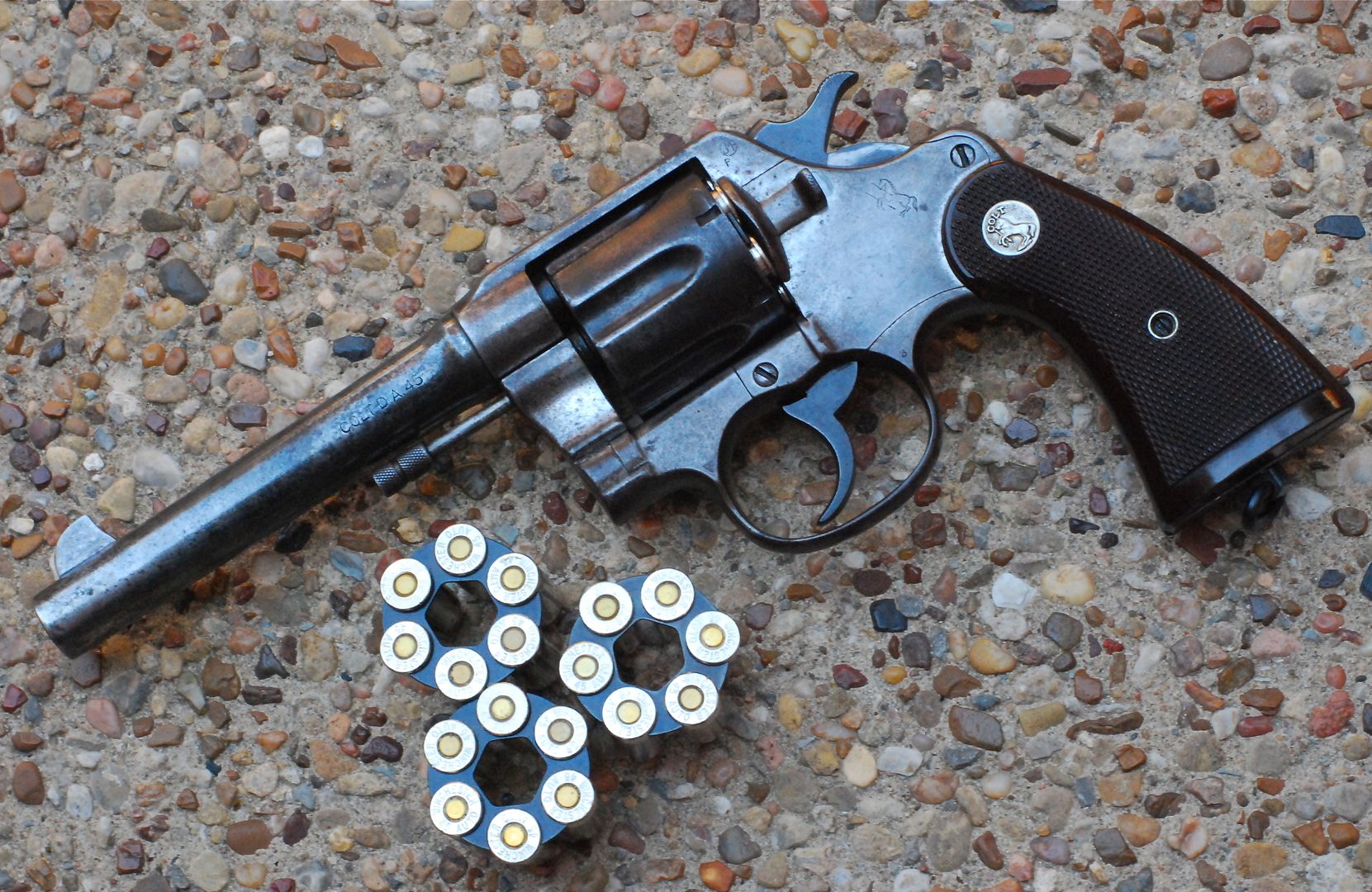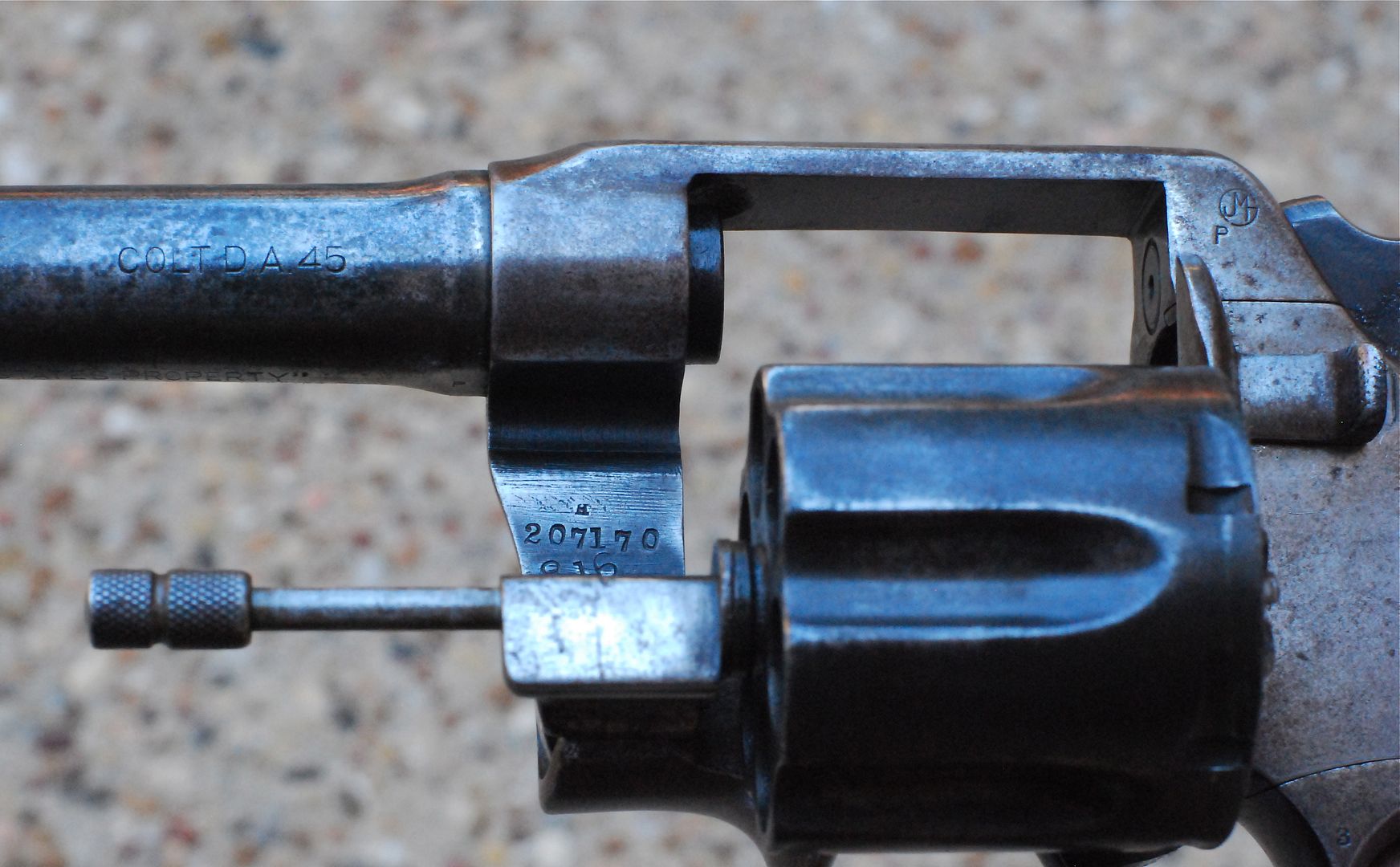I've decided that this yrs gun purchase is going to be a 1917. They are very cool old revolvers and I really have no preference for colt/ s&w, as I think both are beautiful in their own right. I want one that was gi issue. Please educate me on the following: arsenal reworks, can .45 acp be fired w-out moon clips, and any frequent "fatal flaws" or common downsides to these guns. Also, it won't need to be a primo minty specimin, just a good honest old example that I can gently shoot once a year and put back away; rough prices?? I've gotten conflicting intel on various sites and need to get this figured out. Thanks in advance fellas!
You are using an out of date browser. It may not display this or other websites correctly.
You should upgrade or use an alternative browser.
You should upgrade or use an alternative browser.
need educated on colt/ s&w model 1917
- Thread starter jc77
- Start date
I cant say I know that much about them. They were built to supplement the M1911s during WWI which were in short supply.
I had one years ago but lost it in a burglary. I'm looking for another.
Being a revolver shooter I got it thinking I would try it as a bulleye gun. That didn't work out. But as a duty revolver it would have been great.
It really wasn't that much heavier then the Model 28 I carried as a duty revolver.
You either use Moon clips with 45 Auto, or you found some 45 auto rim (much harder to find now then in the 70s when I had mine.
The double action trigger was rough and heavy. Lots of dry firing fixed that a bit. You're lucky if you can get the right ammo/gun combination to get the fix sights to work. But its a combat gun, no a precision target piece.
I like the Smith better then the colt, but that's personal opinion.
I know Brazil made them and they are good revolvers, really not much different then the colts and smiths..........but I'm holding out for a Smith.
Now days they have full moon clips for N-frames, I think that would be a good set up.
The M-1977 would be a great addition to my Early 1900 US military rifle/gear collection.
Sorry I couldn't be more informative. Enjoy your quest and find when you find one.
It would be a fun 3-gun revolver to go with my M-1917 Eddystone and my M-97 Winchester.
I had one years ago but lost it in a burglary. I'm looking for another.
Being a revolver shooter I got it thinking I would try it as a bulleye gun. That didn't work out. But as a duty revolver it would have been great.
It really wasn't that much heavier then the Model 28 I carried as a duty revolver.
You either use Moon clips with 45 Auto, or you found some 45 auto rim (much harder to find now then in the 70s when I had mine.
The double action trigger was rough and heavy. Lots of dry firing fixed that a bit. You're lucky if you can get the right ammo/gun combination to get the fix sights to work. But its a combat gun, no a precision target piece.
I like the Smith better then the colt, but that's personal opinion.
I know Brazil made them and they are good revolvers, really not much different then the colts and smiths..........but I'm holding out for a Smith.
Now days they have full moon clips for N-frames, I think that would be a good set up.
The M-1977 would be a great addition to my Early 1900 US military rifle/gear collection.
Sorry I couldn't be more informative. Enjoy your quest and find when you find one.
It would be a fun 3-gun revolver to go with my M-1917 Eddystone and my M-97 Winchester.
spacecoast
New member
I bought one (a Colt) earlier this year, I believe everything is original and it dates from 1919, although it could be 1918. I paid about $700. It is/was Colt's biggest frame revolver as I understand. Beautiful gun, although not finished as nicely as earlier and later Colts due to the order volume during the Great War. The grip shape keeps it from being comfortable to shoot, at least for me. I agree with Kraig that the trigger is quite heavy. It uses the same full moon clips as I use in my S&W 625, although I believe the original clips were half-moons.
Addendum - these guns have two serials... inside the crane is Colt's number (204xxx in my case) and the butt has the Army's number. The difference in numbers is due to the fact that these were first introduced in 1898 as the New Service revolvers. According to Wilson, Colt sold 151,700 of them to the US Govt. in WWI.
According to the SCSW, S&W sold approx. 163,600 of their Model 1917s to the government during the war. I also recall reading recently (likely on TFL) that most Smiths were arsenal-refinished after the war with a parkerized-type finish like the one Salvadore shows below.
I have examined a Smith before, but not since I got the Colt. It would be interesting to see the similarities and differences in the two side by side. Each retains it distinctive nature (cylinder releases, etc.) while looking very similar to each other. I wonder which the soldiers preferred during and after the war.


Addendum - these guns have two serials... inside the crane is Colt's number (204xxx in my case) and the butt has the Army's number. The difference in numbers is due to the fact that these were first introduced in 1898 as the New Service revolvers. According to Wilson, Colt sold 151,700 of them to the US Govt. in WWI.
According to the SCSW, S&W sold approx. 163,600 of their Model 1917s to the government during the war. I also recall reading recently (likely on TFL) that most Smiths were arsenal-refinished after the war with a parkerized-type finish like the one Salvadore shows below.
I have examined a Smith before, but not since I got the Colt. It would be interesting to see the similarities and differences in the two side by side. Each retains it distinctive nature (cylinder releases, etc.) while looking very similar to each other. I wonder which the soldiers preferred during and after the war.


Last edited:
spacecoast
New member
Spacecoast, about what % condition would you say yours is? That's a beautiful revolver man!
My guess would be about 80%, but it's a little hard to say since these revolvers did not enjoy the highest standards of finish like Colt revolvers before and after the war. There are definite machining and brush marks in the finish where it was done in a "good enough" manner, but that is typical of the wartime guns. Mine definitely has some thinning blue in spots, like around the Rampant Colt, but doesn't have any major nicks or blemishes, at least not to my eye. Another view is below.
Representative samples are not hard to find on Gunbroker since they were made in great numbers. If I were you, I would read up on these guns and watch the new and finished auctions on Gunbroker for a few weeks to get an idea of what's available and for what price. If you can find one or more to fondle in your local gun store or at a gun show, even better. Mine was probably in the midpoint of the spectrum. Then determine what you want to spend and bid on guns meeting your criteria that have a reasonable opening bid.
I like for mine to be all original if possible, I forgot to mention that this one, like many, has the serial number pencilled inside the grips, something a collector always likes to see.
By the way, in another TFL thread (thanks Dfariswheel), I found this link to Colt Model 1917 manufacture dates... http://oldguns.net/sn_php/mildateslookup.php?file=us_m1917colt.dat. It puts my gun at March 1918, which seems more believable than 1919 (Wilson's book), especially with the JMG inspector's initials. Any insight by the experts here would be appreciated. I will also ask on the Colt Forum.
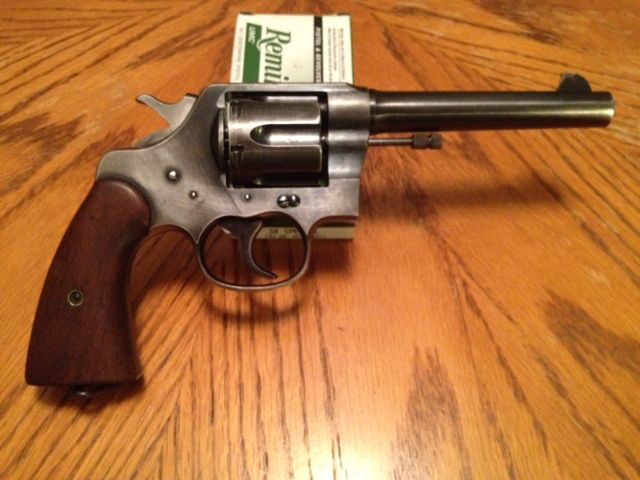
Last edited:
Thanks for the info guys. Does the arsenal rework decrease price/ collectability much?
I don't think so, most of these old USGI Rifle and Pistols were re-built at one time or other.
I wouldn't affect my buying one, except the non-rebuilt guns seem to be abused.
Then again I'm a shooter not a collector. At my age, I wont live long enough for them to go up in value. But I do have a few years left to enjoy them myself.
trigger643
New member
Does the arsenal rework decrease price/ collectability much?
Generally speaking, an original example is worth more than an arsenal refinish. An arsenal refinish is with more than a restored. It comes down to condition and originality.
There is a debate among some about "correct" vs "original". And what is original? How it left the factory? How it appeared in the hands of those who used it? How it left the arsenal for the last time?
Here is one of my M1917 Colt New Service Revolvers. It was returned from France and repaired/overhauled at the Benicia Arsenal sometime prior to 1919 (when they switched from bluing to Parkerizing), and subsequently was a private purchase in 1920.
The right grip and cylinder were replaced. The right grip is from an M1909. The edge of the Arsenal inspector mark struck the grip frame and was applied after the grip was attached. Directly above the the trigger on the frame is a small cut, as if whittled by a pocket knife. At a continuing line with this cut is a small dent in the bridge of the frame, as if made by a punch. It appears what ever made these marks cut the mark in the frame, proceeded through the cylinder and terminated in the bridge of the frame just behind the forcing cone.
Sure, it's probably worth less than an as-new unissued example in the same 98%+ condition. But by how much? That's something only the buyer can decide.
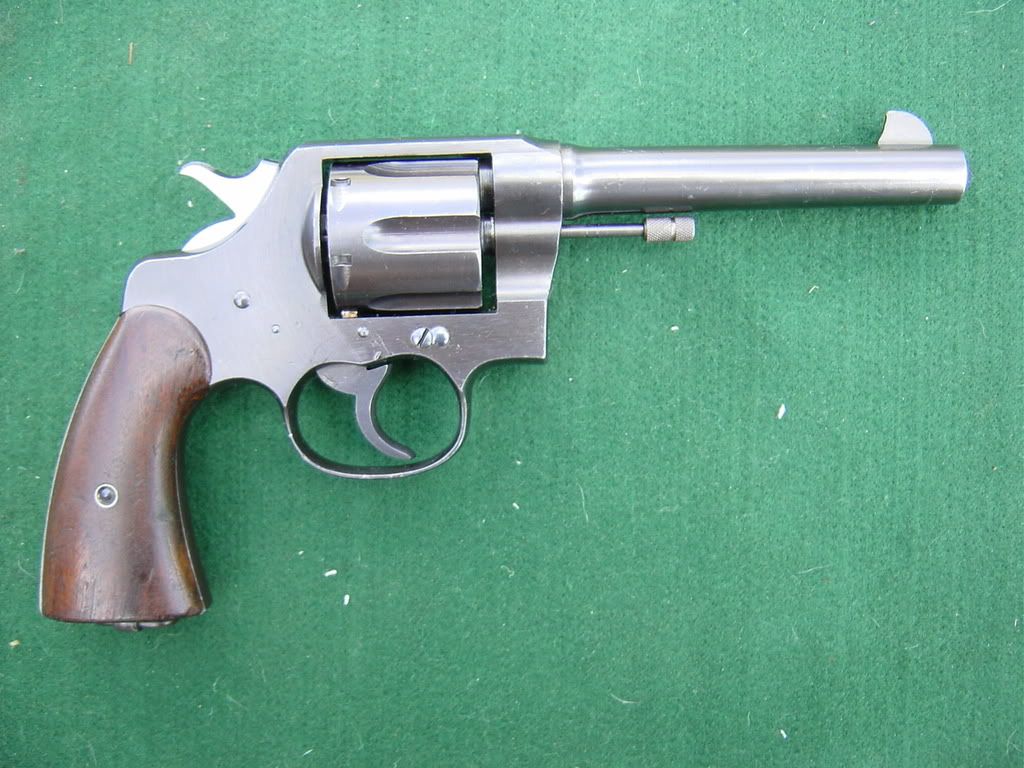
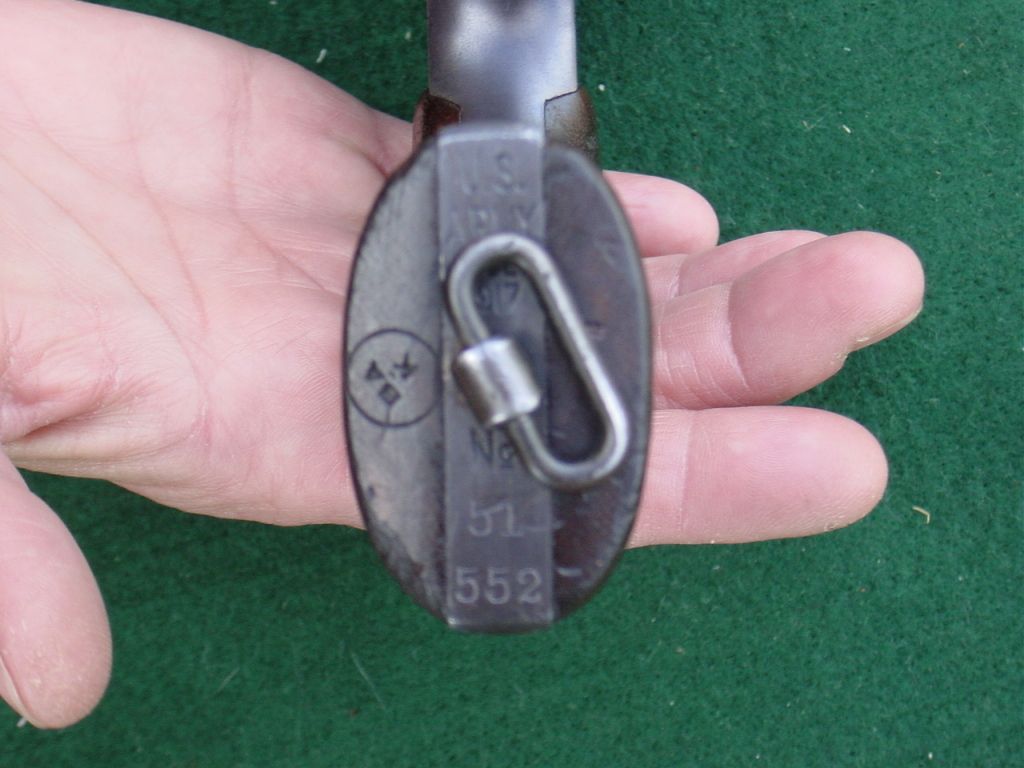

Driftwood Johnson
New member
Howdy
Smith and Wesson first introduced a large frame, side swing revolver in 1908, the 44 Hand Ejector, First Model, also known as the Triple Lock. The standard chambering for this revolver was 44 Special. This continued the tradition of 44 caliber being the preferred caliber in the large frame Smith and Wesson Top Break revolvers of the late 19th Century. The Triple Lock had a shroud over the extractor rod, and a unique extra locking latch in the yoke. The Triple Lock was discontinued in 1915, replaced by the 44 Hand Ejector 2nd Model. This model did away with the third lock, and also did away with the extractor rod shroud, reverting to a simple lug under the barrel that the front of the extractor latched to.
When World War One developed, it became clear that the Army was going to need more sidearms. It was a simple matter for S&W to open up the chambering of the standard 44 Hand Ejector, 2nd Model to accept the 45 ACP cartridge. The chambers were bored so the cartridge would head space on the case mouth. Because there was no rim on the 45 ACP cartridge half moon clips were developed to give the extractor something to grab to extract the empty brass. To allow for the extra thickness of the half moon clips, the space between the rear of the cylinder and the recoil shield was increased by about .030" over the standard spacing for the 44 Special cartridge. Barrel length was fixed at 5 1/2".
Smith and Wesson produced approximately 163,600 of these revolvers between 1917 and 1919, it was named the Model 1917 after the year that it was introduced. Commercial models continued to be produced until 1946, with a total of approximately 209,000 made.
Starting in 1937 S&W produced 25,000 Model 1917s for the Brazilian government. This contract helped keep S&W in business during the depression.
In the 1930s the 45 Auto Rim cartridge was developed with a rim .030 thicker than most cartridges, to allow for extraction without the use of half moon clips.
These photos show a military Model 1917 that shipped in January of 1918 at top, and a Brazilian Contract 1917 at the bottom. The grips on the military gun are probably not correct for the model, but they are what it came with and I like them.
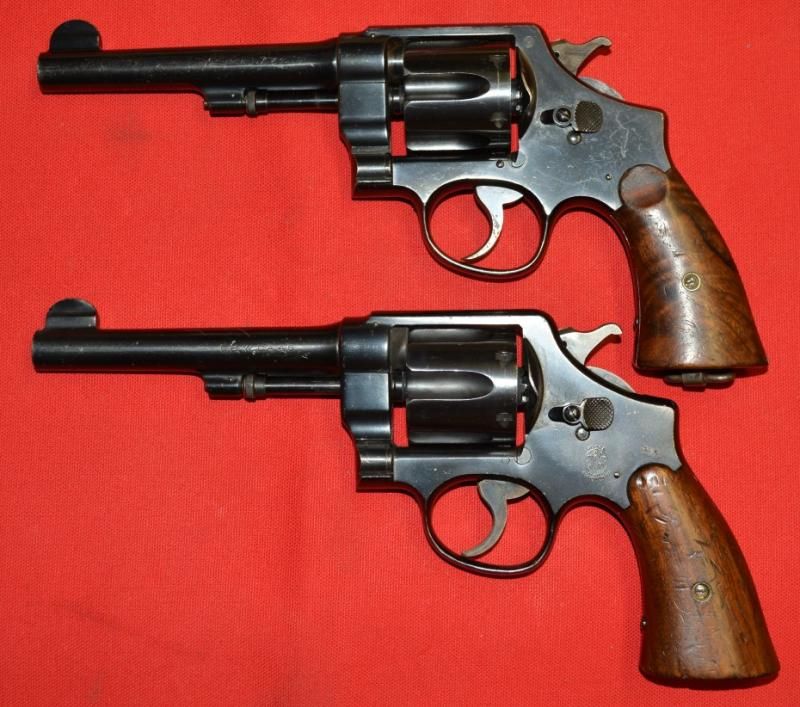
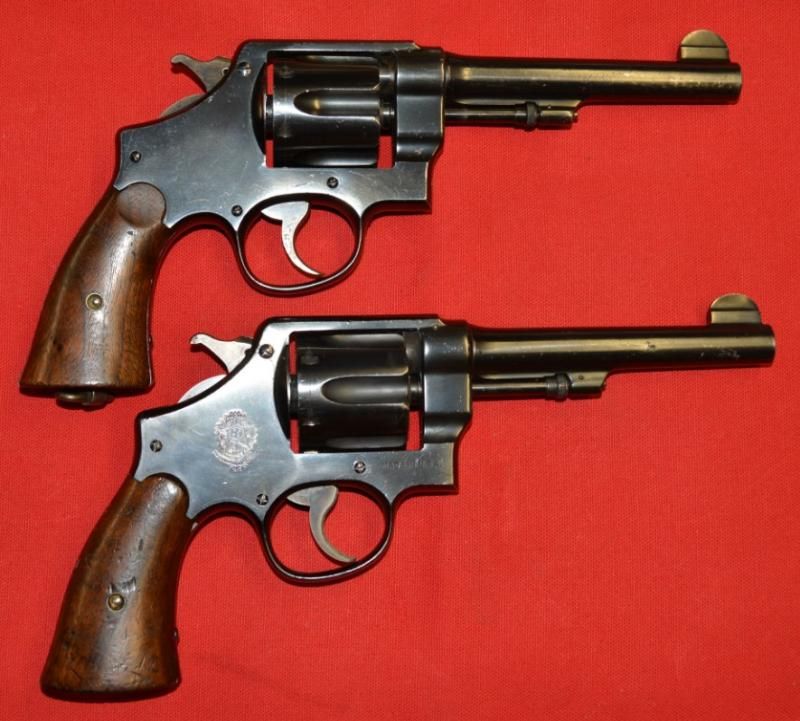
Here is a closeup of the shield on the side plate of the Brazilian Contract gun.
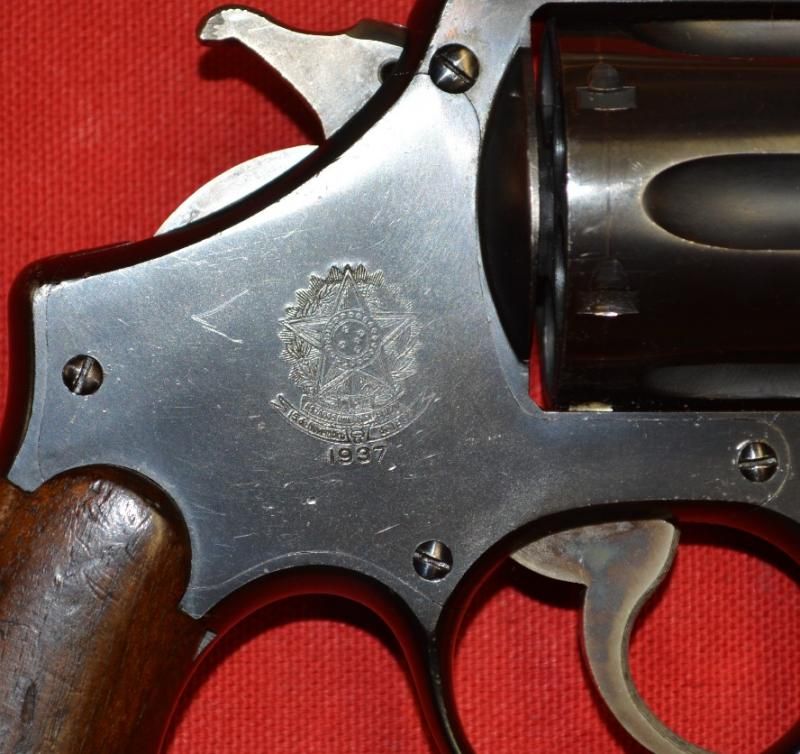
Most military 1917s have the US Ordinance flaming bomb on the left side of the frame in front of the hammer. This 1917 has an inspector's mark instead. GHS shows that Major Gilbert H Stewart was the inspector. This 1917 also has a relatively unusual grooved sided hammer. The grooves were thought to help keep the sides of the hammer lubricated, but the idea was eventually dropped.
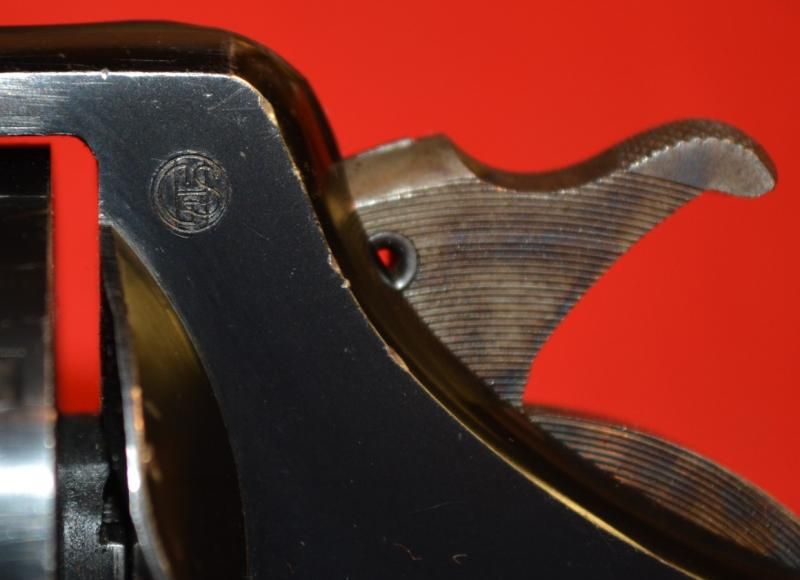
Because the cartridge headspaces on the case mouth, S&W 1917 revolvers can chamber and fire 45 ACP cartridges without half moon clips, but the empties have to be poked out with a stick or a pencil. 45 Auto Rim brass is readily available from Starline. Load data is the same as 45 ACP and they can be loaded with standard 45 ACP dies, but you need a different shell holder. The cartridges in this photo are, left to right, 45 Colt, 45 Schofield, 45 ACP, and 45 Auto Rim. Notice how the rim of the Auto Rim cartridge is thicker (.090) than the other cartridges, to take up the extra space behind the cylinder in the 1917 revolvers.
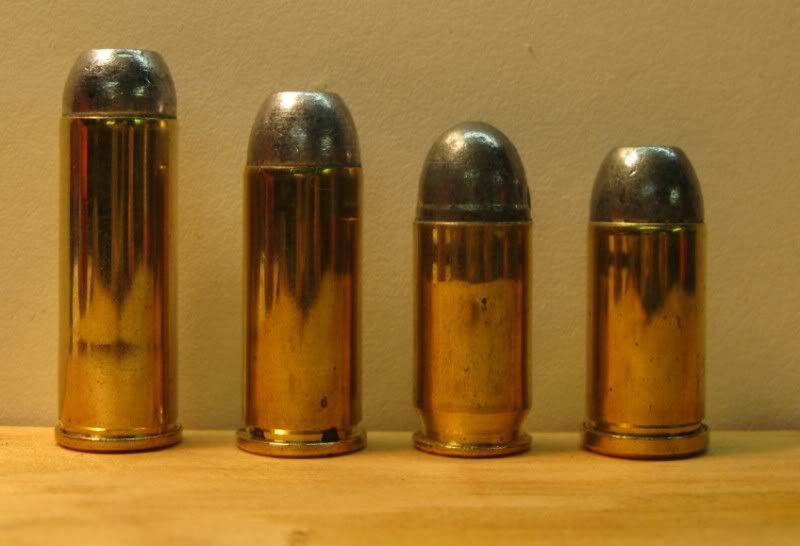
Brazillian contract guns are usually available for less money than a military model 1917. Many of them were shipped back to the US and imported in the 1990s. Unfortunately, many of these appear to have just been thrown into a box with little protection, many of them are dinged up. The one in the photo is all dinged up. I have another Brazilian contract gun that was refinished. Unfortunately whoever refinished it was heavy handed with the polishing wheel. The Brazilian contract shield is half polished away.
Smith and Wesson first introduced a large frame, side swing revolver in 1908, the 44 Hand Ejector, First Model, also known as the Triple Lock. The standard chambering for this revolver was 44 Special. This continued the tradition of 44 caliber being the preferred caliber in the large frame Smith and Wesson Top Break revolvers of the late 19th Century. The Triple Lock had a shroud over the extractor rod, and a unique extra locking latch in the yoke. The Triple Lock was discontinued in 1915, replaced by the 44 Hand Ejector 2nd Model. This model did away with the third lock, and also did away with the extractor rod shroud, reverting to a simple lug under the barrel that the front of the extractor latched to.
When World War One developed, it became clear that the Army was going to need more sidearms. It was a simple matter for S&W to open up the chambering of the standard 44 Hand Ejector, 2nd Model to accept the 45 ACP cartridge. The chambers were bored so the cartridge would head space on the case mouth. Because there was no rim on the 45 ACP cartridge half moon clips were developed to give the extractor something to grab to extract the empty brass. To allow for the extra thickness of the half moon clips, the space between the rear of the cylinder and the recoil shield was increased by about .030" over the standard spacing for the 44 Special cartridge. Barrel length was fixed at 5 1/2".
Smith and Wesson produced approximately 163,600 of these revolvers between 1917 and 1919, it was named the Model 1917 after the year that it was introduced. Commercial models continued to be produced until 1946, with a total of approximately 209,000 made.
Starting in 1937 S&W produced 25,000 Model 1917s for the Brazilian government. This contract helped keep S&W in business during the depression.
In the 1930s the 45 Auto Rim cartridge was developed with a rim .030 thicker than most cartridges, to allow for extraction without the use of half moon clips.
These photos show a military Model 1917 that shipped in January of 1918 at top, and a Brazilian Contract 1917 at the bottom. The grips on the military gun are probably not correct for the model, but they are what it came with and I like them.


Here is a closeup of the shield on the side plate of the Brazilian Contract gun.

Most military 1917s have the US Ordinance flaming bomb on the left side of the frame in front of the hammer. This 1917 has an inspector's mark instead. GHS shows that Major Gilbert H Stewart was the inspector. This 1917 also has a relatively unusual grooved sided hammer. The grooves were thought to help keep the sides of the hammer lubricated, but the idea was eventually dropped.

Because the cartridge headspaces on the case mouth, S&W 1917 revolvers can chamber and fire 45 ACP cartridges without half moon clips, but the empties have to be poked out with a stick or a pencil. 45 Auto Rim brass is readily available from Starline. Load data is the same as 45 ACP and they can be loaded with standard 45 ACP dies, but you need a different shell holder. The cartridges in this photo are, left to right, 45 Colt, 45 Schofield, 45 ACP, and 45 Auto Rim. Notice how the rim of the Auto Rim cartridge is thicker (.090) than the other cartridges, to take up the extra space behind the cylinder in the 1917 revolvers.

Brazillian contract guns are usually available for less money than a military model 1917. Many of them were shipped back to the US and imported in the 1990s. Unfortunately, many of these appear to have just been thrown into a box with little protection, many of them are dinged up. The one in the photo is all dinged up. I have another Brazilian contract gun that was refinished. Unfortunately whoever refinished it was heavy handed with the polishing wheel. The Brazilian contract shield is half polished away.
Last edited:
Driftwood Johnson
New member
I have examined a Smith before, but not since I got the Colt. It would be interesting to see the similarities and differences in the two side by side. Each retains it distinctive nature (cylinder releases, etc.) while looking very similar to each other. I wonder which the soldiers preferred during and after the war.
Howdy
Not a Colt 1917, but a New Service, the same basic frame that the Colt 1917 used. It is a bigger gun than the S&W Model 1917. It is the largest revolver I own.
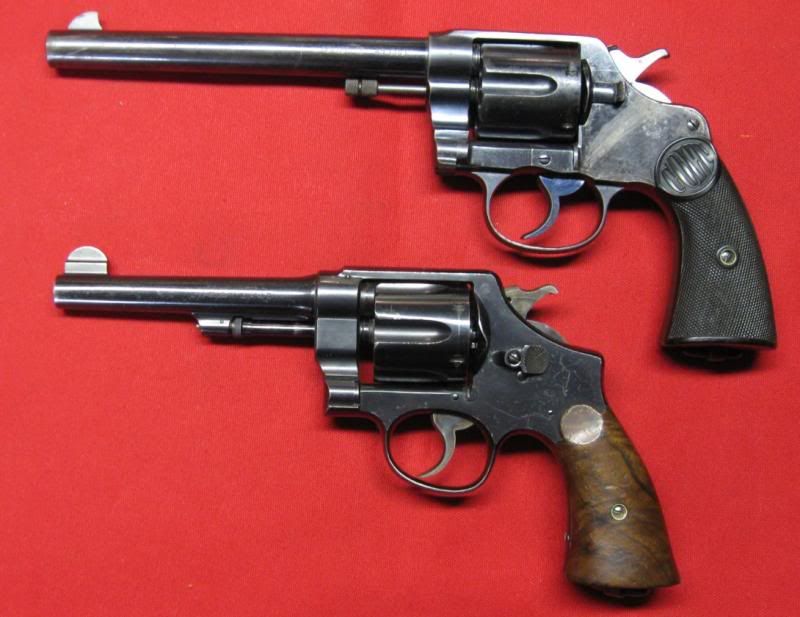
I've had mine for over 30 years, my S&W has a smoother action, the Colt was made in 1917 so it might have been "Over There". If the chambers are bored for 45ACP you can fire with out moon clips, cases must be picked out individually. When it comes to USGI firearms I distinguish between "factory correct" and "period correct". Do you want one that is correct for 1917-1918 or one that is GI correct ?
Mike Irwin
Staff
In general, you can shoot .45 ACP cases without moon clips. The case rests on shoulders in the chamber, providing proper headspacing. Ejection has to be done with a pencil, though.
The only caveat to that is that early Colts did not have the shoulders, so you MUST use moonclips with them.
Regarding the Brazilian guns...
These guns were made, and delivered, in two distinct runs.
The first run of guns was made and delivered in the run up to World War II production.
The second run of guns was made and delivered after Smith & Wesson was released from its US Government wartime contracts. I believe the final guns were delivered in early 1946.
I don't have production numbers on the two runs at hand.
The two runs are not identical.
The early run used what I call the "wing" hammer block, which was fitted in the sideplate. This was the standard S&W hammer block until 1944.
The second run of guns used the now-standard "L" shaped sliding hammer block.
Earlier models should be inspected VERY carefully to ensure that the hammer block is free to move in the side plate. Dirt and dried oil can make it stick in the off position.
The only caveat to that is that early Colts did not have the shoulders, so you MUST use moonclips with them.
Regarding the Brazilian guns...
These guns were made, and delivered, in two distinct runs.
The first run of guns was made and delivered in the run up to World War II production.
The second run of guns was made and delivered after Smith & Wesson was released from its US Government wartime contracts. I believe the final guns were delivered in early 1946.
I don't have production numbers on the two runs at hand.
The two runs are not identical.
The early run used what I call the "wing" hammer block, which was fitted in the sideplate. This was the standard S&W hammer block until 1944.
The second run of guns used the now-standard "L" shaped sliding hammer block.
Earlier models should be inspected VERY carefully to ensure that the hammer block is free to move in the side plate. Dirt and dried oil can make it stick in the off position.
Mike Irwin
Staff
A word of advice on these guns...
I don't know about the Colts, but original S&W 1917s did not have heat treated cylinders. There is some speculation that the chambers were intentionally cut oversized on the S&Ws so as to reduce the operating pressure of standard .45 ACP ammo and ease stress on the gun as it was firing military hardball.
.45 Auto Rim ammunition, which Peters developed around 1920-1921 for these guns as they made their was into the civilian market, was generally downloaded a bit, which is still often reflected in handloading data for the cartridge.
I don't shoot ball ammo through my Brazilian copy even though it does have a heat treated cylinder. I only shoot lead.
I don't know about the Colts, but original S&W 1917s did not have heat treated cylinders. There is some speculation that the chambers were intentionally cut oversized on the S&Ws so as to reduce the operating pressure of standard .45 ACP ammo and ease stress on the gun as it was firing military hardball.
.45 Auto Rim ammunition, which Peters developed around 1920-1921 for these guns as they made their was into the civilian market, was generally downloaded a bit, which is still often reflected in handloading data for the cartridge.
I don't shoot ball ammo through my Brazilian copy even though it does have a heat treated cylinder. I only shoot lead.
carguychris
New member
Additionally, IIRC the second run had a more squared-off rear sight shape, due to the more angular frame contour used on postwar N frames.Mike Irwin said:Regarding the Brazilian guns...
These guns were made, and delivered, in two distinct runs... The two runs are not identical.
The early run used what I call the "wing" hammer block, which was fitted in the sideplate. This was the standard S&W hammer block until 1944.
The second run of guns used the now-standard "L" shaped sliding hammer block.
Correct; this can be checked without disassembly by peering into the hammer recess as the hammer is thumb-cocked. You should see a rectangular metal piece withdraw to the right.Mike Irwin said:Earlier models should be inspected VERY carefully to ensure that the hammer block is free to move in the side plate. Dirt and dried oil can make it stick in the off position.
BTW the early "wing" hammer block, while better than nothing, should NOT be relied upon as a safety device unless it is frequently inspected for proper function, and arguably not even then. Asides from the jamming problem, it is also known to break completely; in either case, it essentially disengages itself, with no external indication that anything is wrong.
Last edited:
Mike Irwin
Staff
"In either case, the spring is prone to metal fatigue, and replacements are virtually impossible to obtain."
I'll mention the same thing I mentioned in the thread about the Model of 1902...
"Yes, there are parts available for an S&W that old.
But finding them means selling your soul to one of the hard-core S&W collectors/restorers who has amassed a supply of parts for the early guns.
Ask me know I know.... "
"
I'll mention the same thing I mentioned in the thread about the Model of 1902...
"Yes, there are parts available for an S&W that old.
But finding them means selling your soul to one of the hard-core S&W collectors/restorers who has amassed a supply of parts for the early guns.
Ask me know I know....


